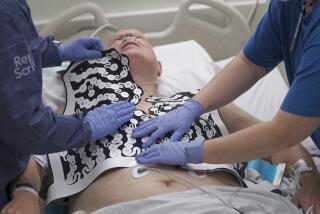Electrical Implant May Help Severely Depressed
- Share via
PITTSBURGH — Many patients with the kind of depression that sabotages the ability to form relationships or keep a job have long thought that medicines or shock therapy were their only hope.
But doctors at 20 research centers around the country are studying how a surgically implanted stopwatch-sized device could offer an alternative treatment for profound depression.
Dr. Robert H. Howland, an associate professor of psychiatry at the University of Pittsburgh Medical Center’s Western Psychiatric Institute and Clinic, said the vagus nerve stimulator acts like a pacemaker for the brain. Where a cardiac pacemaker uses electric pulses to regulate the heart, the stimulator uses electric pulses to regulate the brain.
Originally designed and used to treat epileptic seizures, the stimulator sends pulses to the brain stem through the vagus nerve, which stretches through the neck near the carotid artery. The pulses usually last about 30 seconds and happen every three to five minutes.
The circular device is made from materials that are used in pacemakers. It sits in the chest, with small wires leading to the vagus nerve.
This nerve, a powerful path between the brain and the body, reaches the section of the brain that controls emotion, called the limbic system, Howland said.
Tests conducted on patients who used the stimulator to treat depression showed the device increased activity in the thalamus and the brain stem. Tests also showed that patients had an increased blood flow in areas of the brain stem known to be related to depression.
Unlike medications that go through the bloodstream and chemically affect these sections of the brain, the stimulator takes a shortcut, Howland said.
A pilot study conducted last year prompted researchers to think the stimulator might better treat patients who were not helped by antidepressants and electroconvulsive therapy, or shock therapy.
Researchers say the stimulator helped 12 of 30 patients in the pilot study. Patients who experienced positive results did not notice them immediately after the surgery, and some used the stimulator along with talk therapy and antidepressants.
Lauri Sandoval, a participant in the pilot study, said she tried almost every antidepressant available and was set to start electroconvulsive therapy when she heard about the vagus nerve stimulator.
“I was so desperate and depressed that I wasn’t even scared of it, even though it hadn’t been studied before,” Sandoval said.
The 42-year-old from Santa Fe, N.M., said she had suffered from depression for 30 years, and it got so severe that it was difficult for her to hold a job.
Eighteen months after having the device implanted, Sandoval says she feels dramatically better.
“I used to be a hermit, and I tried to pretend that I wasn’t depressed. I would stay in bed as long as I could. I would get up to go to work, or to walk my dogs, but after a while that would even be difficult,” said Sandoval, who takes medication and attends therapy sessions in addition to using the stimulator.
Another participant in the pilot study, Tucker Davis, said that he often feels a tingle or a hoarseness in his throat.
Doctors believe the “tickle” is caused by the stimulator’s periodic pulses. But researchers believe that this, and replacing the battery every 13 years, are the only clear hassles patients face.
Davis, 48, who lives in the Fort Worth, Texas, area, said he uses a small magnet to reset the device if the tingle bothers him too much.
“Believe me, I don’t mind,” he said.
Like Sandoval, Davis was considering going through electroconvulsive therapy but feared the treatment’s side effects. Many patients who have this therapy suffer from short-term memory loss.
Patients also might not feel the device’s effects right away. For example, Sandoval and Davis said they did not feel better for three months.
Physicians can adjust the intensity, duration and frequency of the stimulation, which may be minimally noticeable by the patient, in follow-up visits.
Howland and Dr. David Adelson, an associate professor of neurosurgery at the University of Pittsburgh, will collaborate on the new 12-week blind clinical study of 30 patients.
As in the pilot study, researchers at the University of Pittsburgh and other centers will use a stimulator designed by Cyberonics Inc., called the NeuroCybernetics Prosthesis. Cyberonics is funding the study.
Spokeswoman Helen Shik said the company is waiting for the Food and Drug Administration to approve its use in treating depression.
The FDA approved use of the stimulator to control epileptic seizures in 1997. Howland said that as doctors treated more epileptic patients with the device, they noticed a boost in the patients’ moods.
He and Adelson will send recommendations to the FDA on whether the device should be approved for treating depression when their study concludes.
Adelson has implanted the device in about 75 patients since its approval for seizure treatment. But he said he couldn’t be sure if the stimulator or decreases in seizures improved patients’ moods.
“Patients can be very depressed because their seizures are not under control and the episodes are taking over their lives,” Adelson said. “I thought I was seeing very positive results because the patients were at the end of their rope and they found another option.”
Howland said the clinical study is double blind, which means the stimulator will be implanted in all participants but activated in only half.
Neither the patients nor the doctors will know which stimulators are turned on, allowing the researchers to determine if the patients are influenced by the placebo effect.






